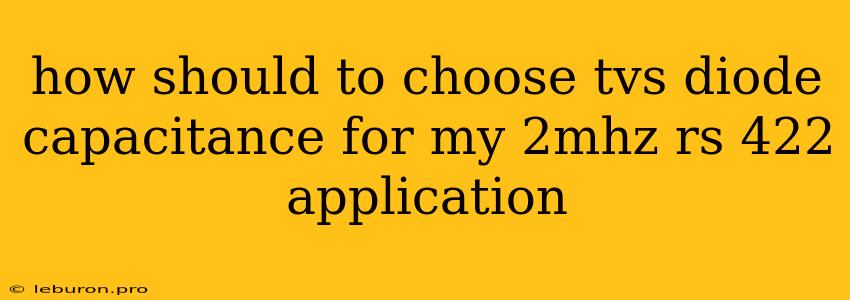Selecting the appropriate TVS diode capacitance for a 2 MHz RS-422 application is crucial to ensure proper signal integrity and reliable communication. While TVS diodes offer essential protection against transient voltage surges, their capacitance can impact signal timing and introduce unwanted noise. This article will delve into the considerations involved in choosing the right TVS diode capacitance for your specific RS-422 application, focusing on the trade-offs and best practices for optimal performance.
Understanding TVS Diode Capacitance and Its Impact on RS-422 Applications
TVS diodes, or Transient Voltage Suppressors, are semiconductor devices designed to absorb and shunt away transient voltage surges, protecting sensitive electronic components from damage. However, inherent in their design is capacitance, which can become a factor in high-speed data applications like RS-422.
Capacitance and Signal Integrity
Capacitance in an electronic circuit can affect signal integrity in several ways:
- Signal Attenuation: Capacitance acts as a filter, attenuating high-frequency signals. In a 2 MHz RS-422 system, this attenuation could distort the signal edges, potentially leading to communication errors.
- Signal Delay: Capacitance causes a delay in signal propagation due to the time it takes to charge and discharge the capacitor. This delay can disrupt timing critical for proper RS-422 communication.
- Reflections: In high-speed applications like RS-422, the capacitance of a TVS diode can reflect signals back toward the transmitter, potentially interfering with data transmission.
Choosing the Right Capacitance for RS-422
When selecting a TVS diode for a 2 MHz RS-422 application, the goal is to find a balance between adequate transient voltage protection and minimal impact on signal integrity. Here's a breakdown of key factors to consider:
1. Operating Frequency: 2 MHz is a relatively low frequency for high-speed applications. However, capacitance still needs consideration to avoid significant signal attenuation or delay.
2. Signal Rise/Fall Times: The speed of the signal edges (rise and fall times) directly impacts the sensitivity to capacitance. Faster rise/fall times require lower capacitance for minimal distortion.
3. Impedance Matching: Mismatched impedances between the transmission line and the TVS diode can lead to signal reflections. Ideally, the TVS diode should have an impedance that is similar to the line impedance.
4. TVS Diode Type: The specific type of TVS diode can influence its capacitance. Unipolar TVS diodes typically have lower capacitance compared to bidirectional TVS diodes, making them a better choice for high-speed applications.
Strategies for Minimizing Capacitance Effects in RS-422
Several strategies can minimize the detrimental effects of TVS diode capacitance:
- Select Low-Capacitance TVS Diodes: Prioritize TVS diodes with low capacitance ratings, especially for critical signal lines.
- Use Separate TVS Diodes for Power and Signal Lines: Avoid placing TVS diodes directly in the path of high-speed signal lines. Utilize separate TVS devices for protecting power supply lines and separate the signal protection to minimize signal degradation.
- Optimize PCB Layout: Carefully design the Printed Circuit Board (PCB) layout to minimize the impact of capacitance. Use short traces and avoid routing high-speed signals near high-capacitance components.
- Consider Using Bypass Capacitors: If necessary, add bypass capacitors near the TVS diodes to shunt away high-frequency noise and minimize signal attenuation.
Examples of TVS Diodes for RS-422 Applications
Here are some examples of TVS diodes that are suitable for RS-422 applications:
- Littelfuse SMBJ Series: These unidirectional TVS diodes offer low capacitance values, typically in the range of picofarads, making them suitable for high-frequency applications.
- Vishay Semiconductors SMAJ Series: This series of unidirectional TVS diodes also boasts low capacitance values, making them ideal for protecting high-speed signals.
Remember that the specific TVS diode selection will depend on the application requirements and the chosen protection level.
Conclusion
Choosing the right TVS diode capacitance for a 2 MHz RS-422 application is a critical aspect of ensuring proper signal integrity and reliable communication. By understanding the potential impact of capacitance and employing strategies to mitigate its effects, you can successfully protect your RS-422 system against transient voltage surges without sacrificing signal quality. When in doubt, it is always recommended to consult with a specialist or a qualified engineer to ensure optimal TVS diode selection and application for your particular RS-422 project.
